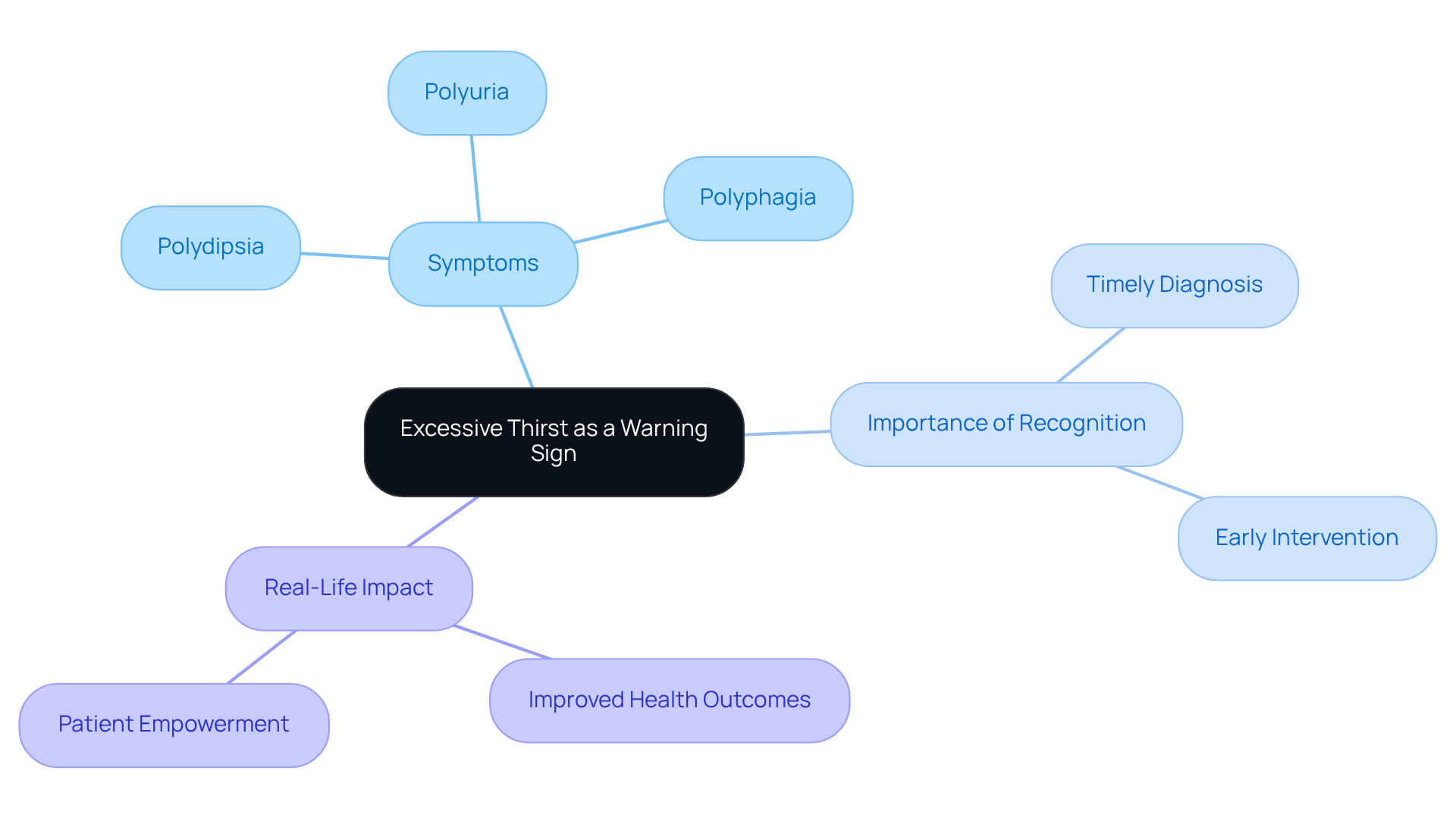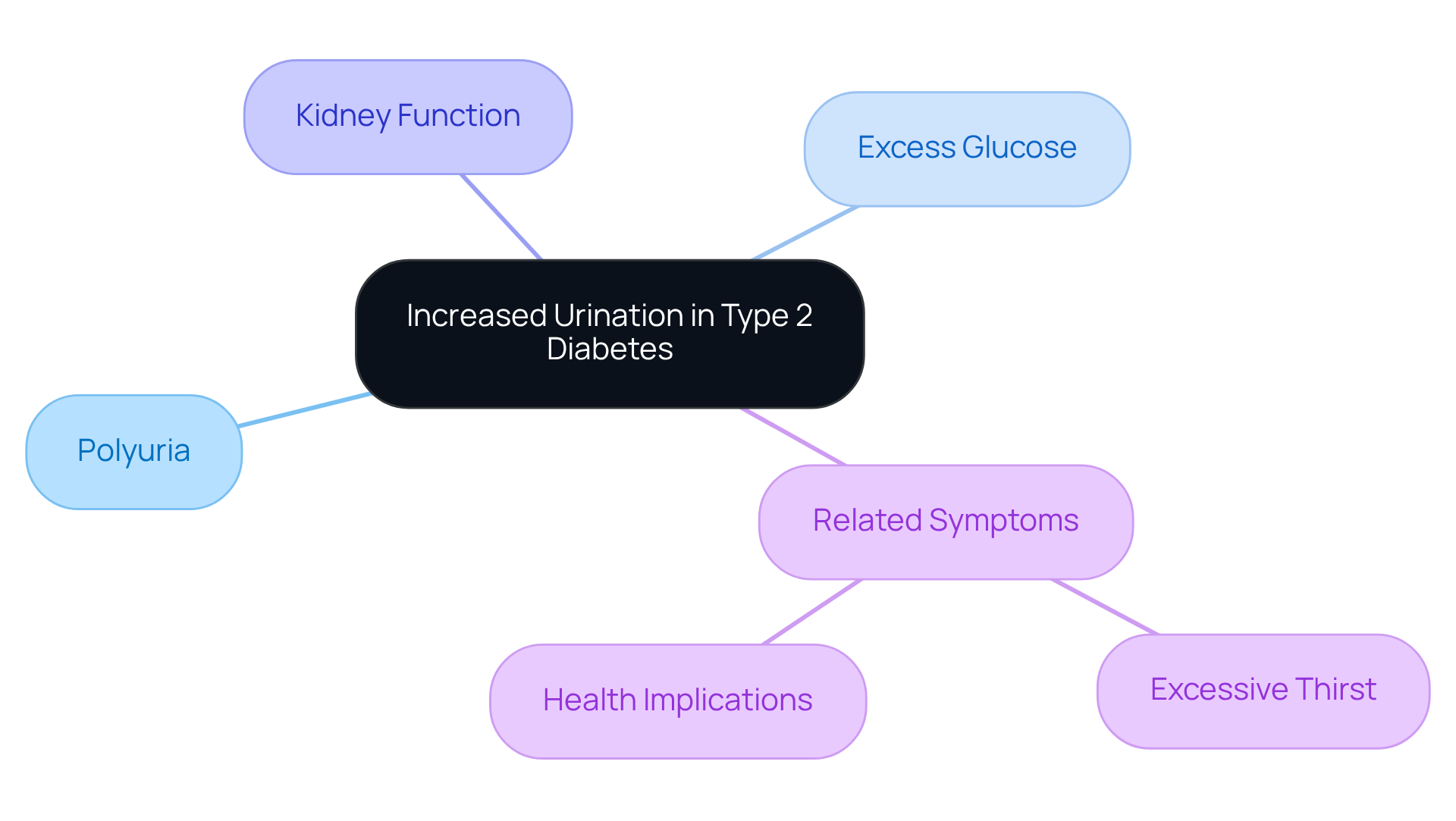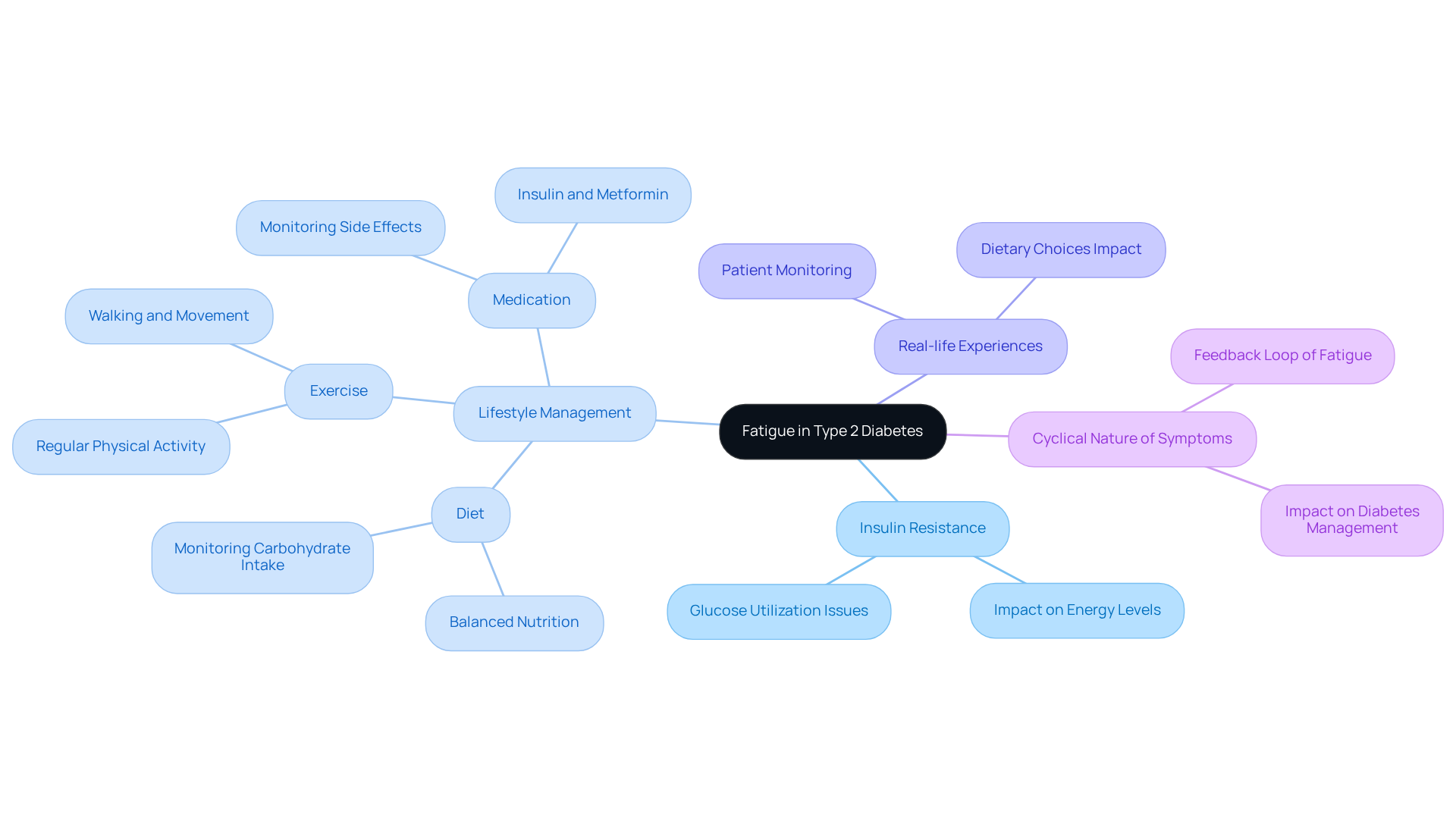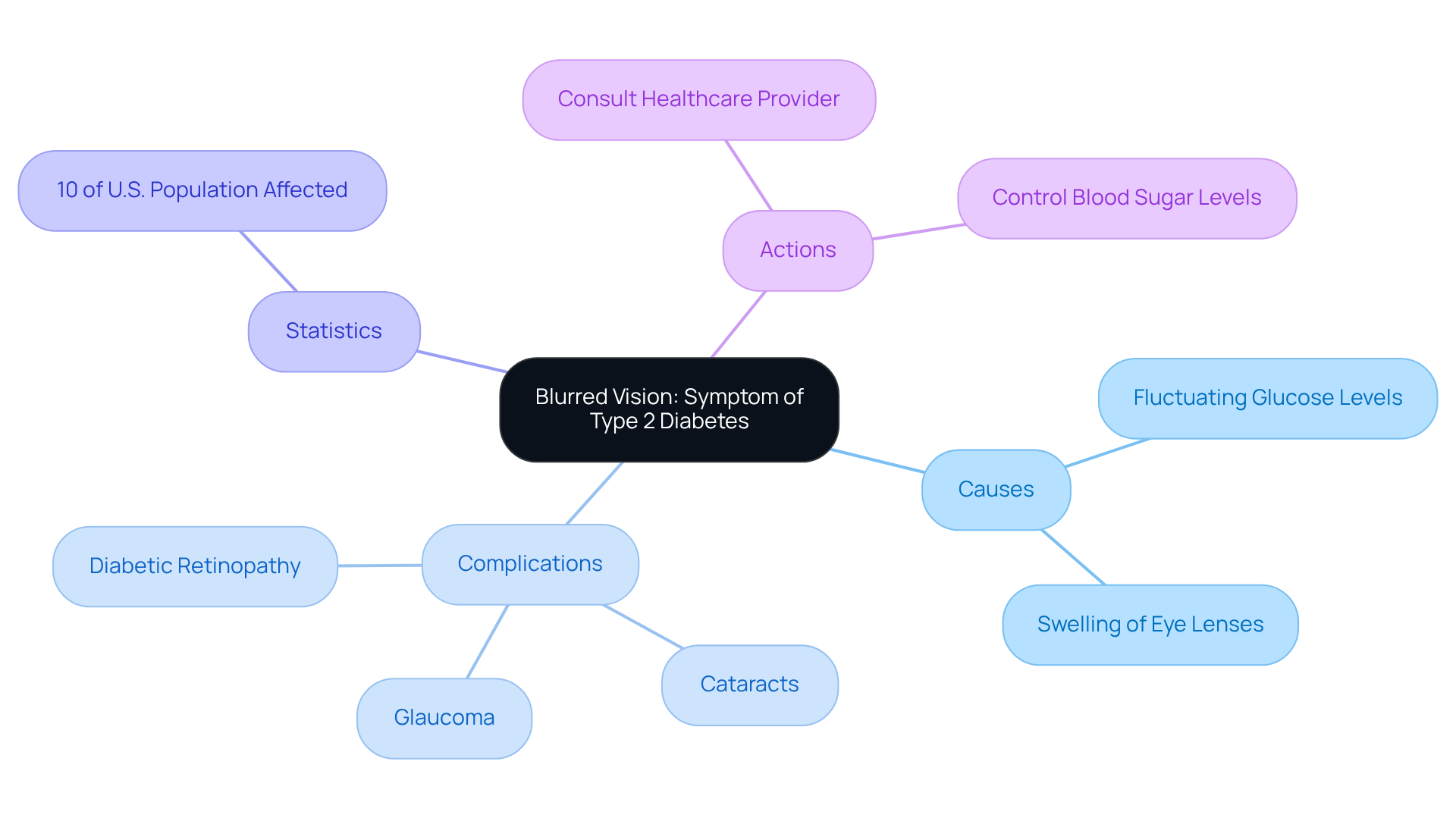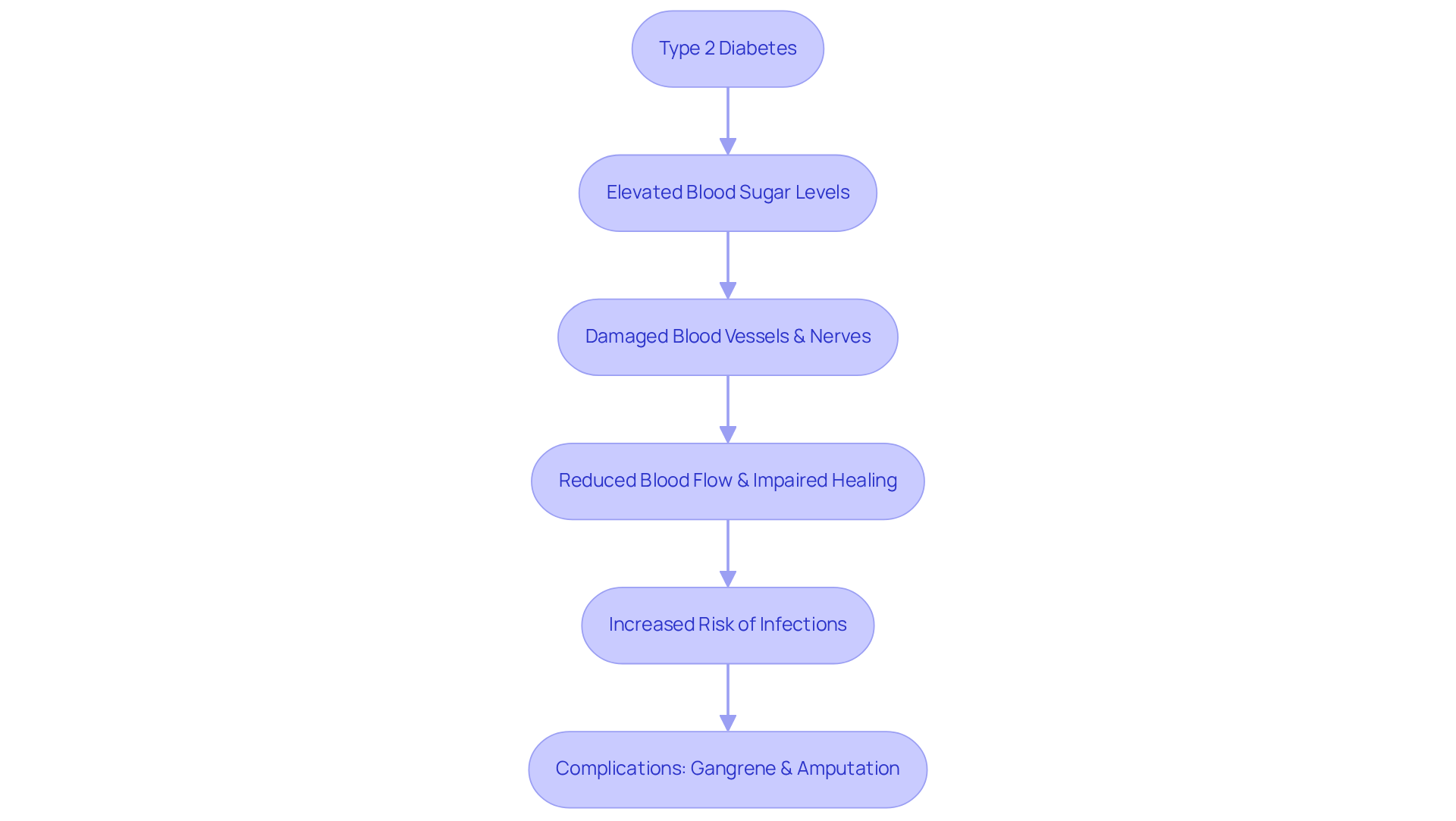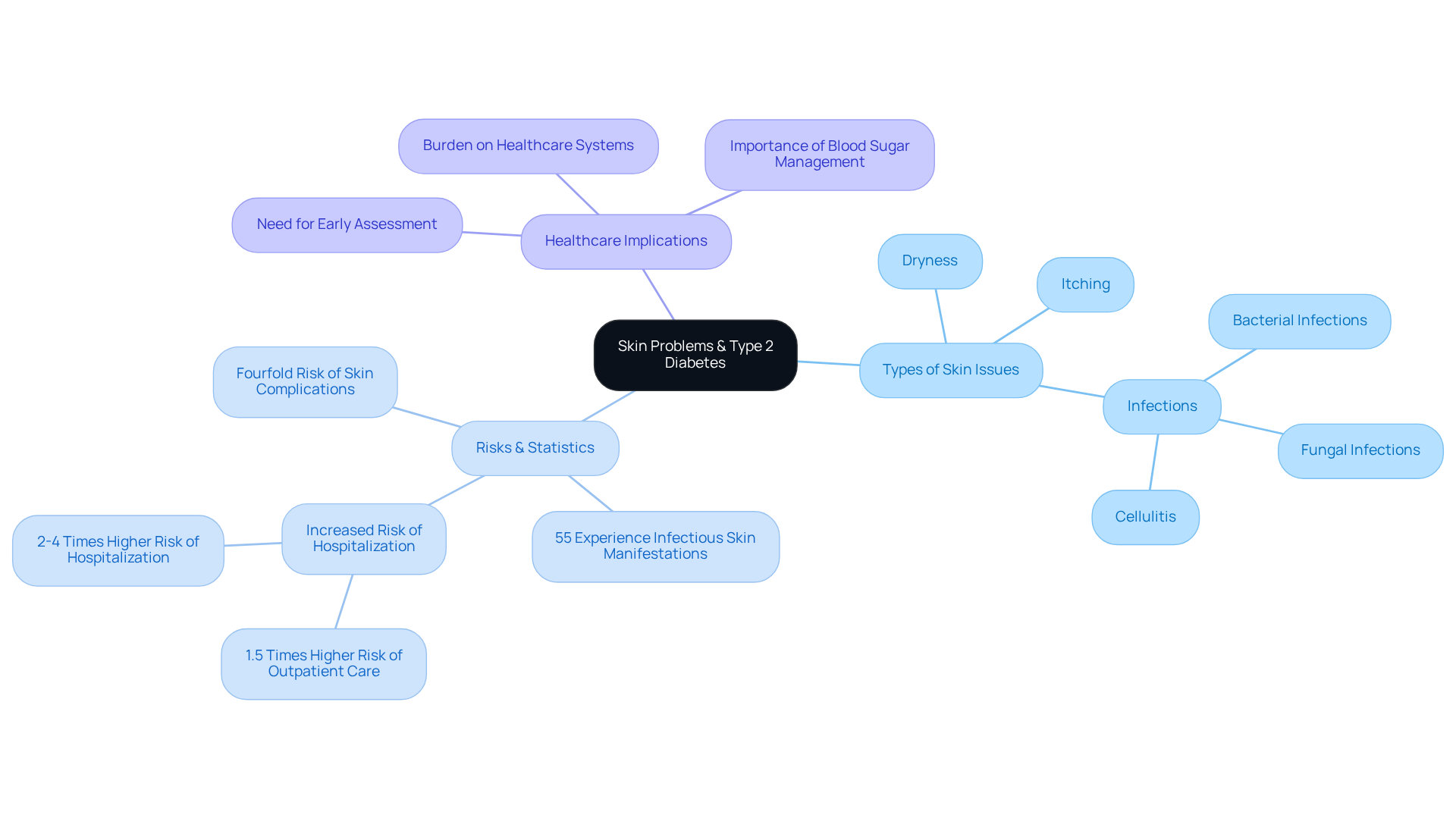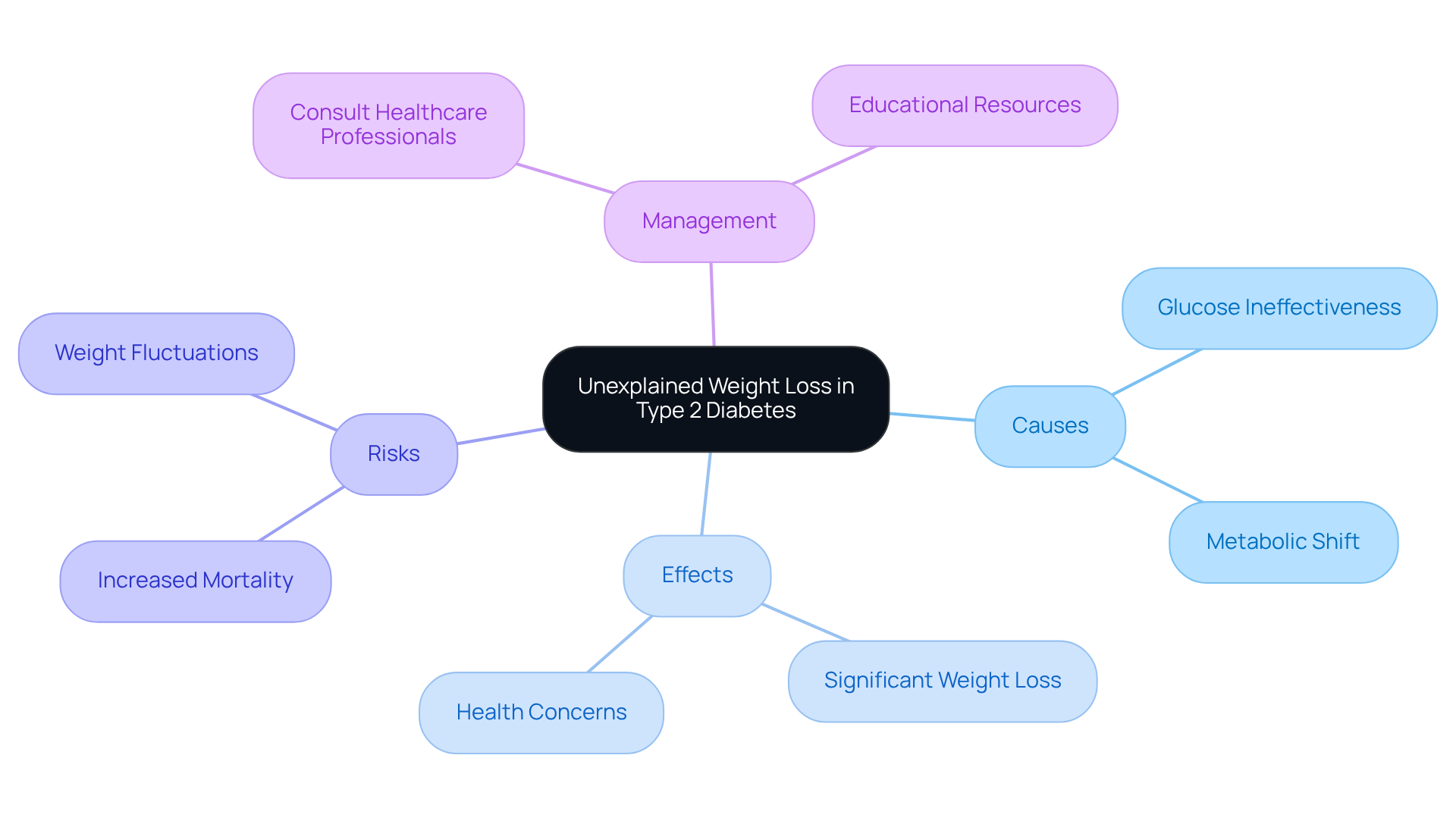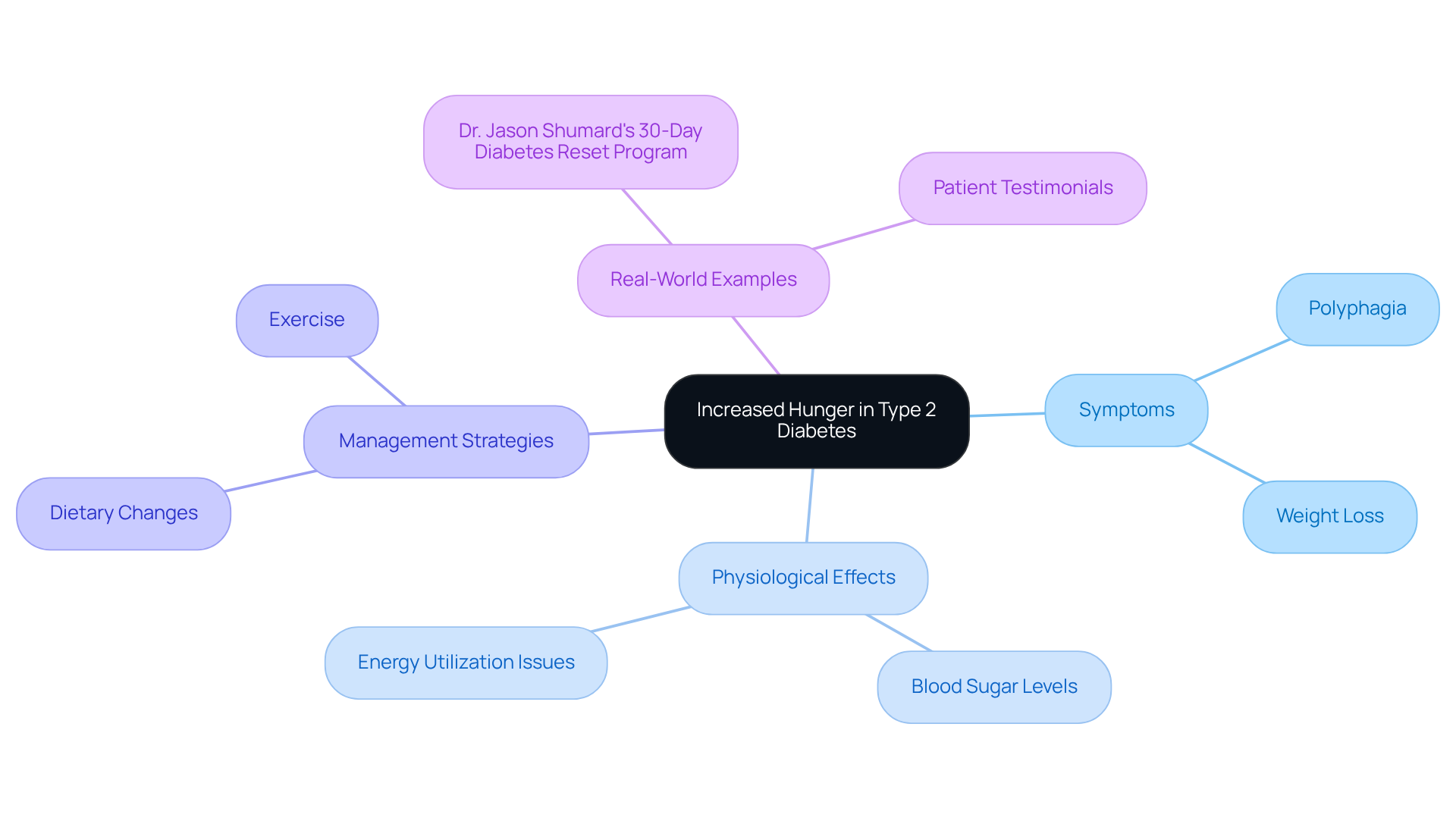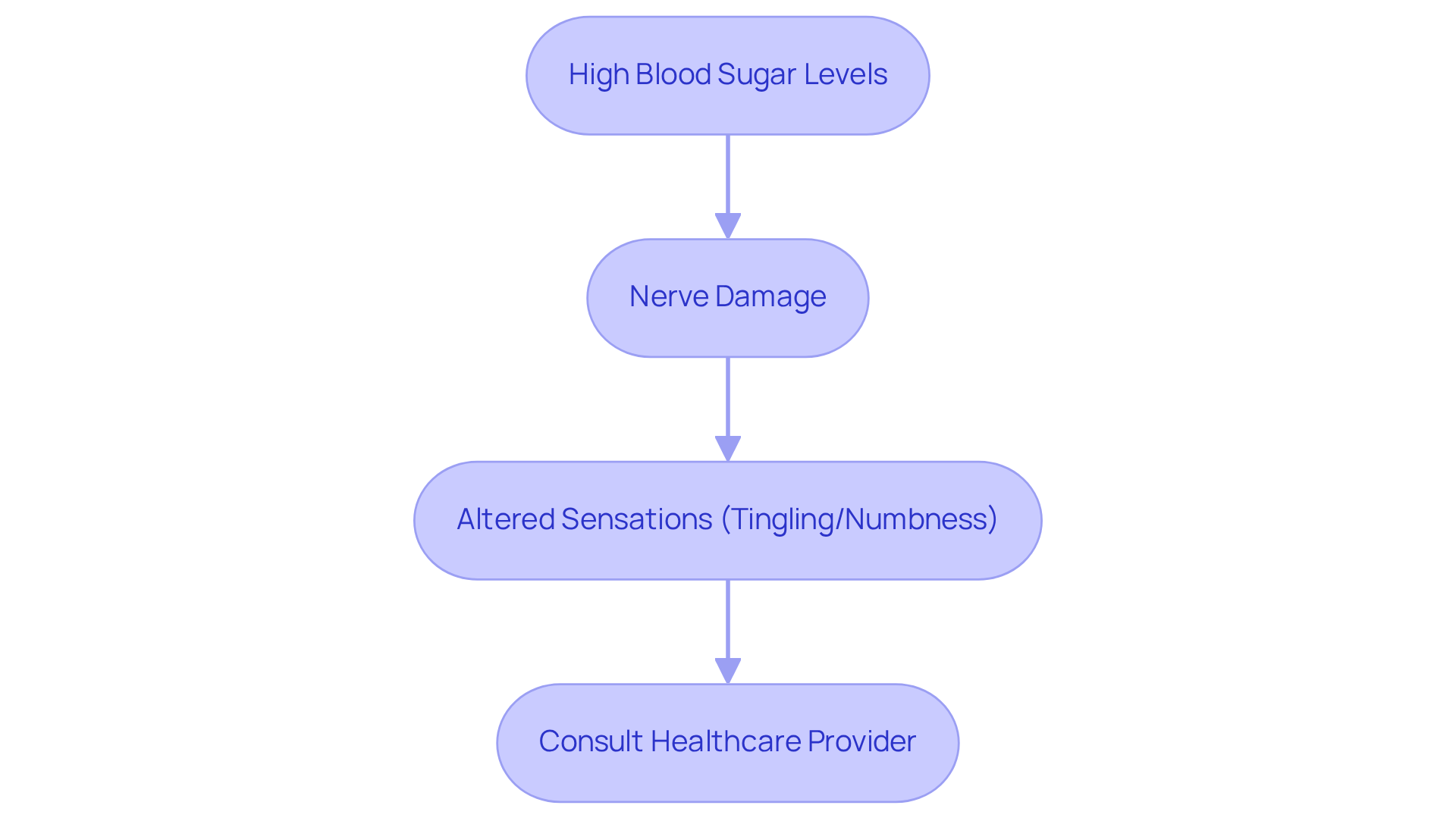Overview
Recognizing the signs of Type 2 diabetes is crucial for your health journey. This article highlights ten key symptoms that serve as important warning signs. It’s essential to be aware of these indicators, such as:
- Excessive thirst
- Frequent urination
- Fatigue
As they can significantly impact your well-being. Early detection and management of these symptoms can prevent further complications and lead to better health outcomes.
Many individuals struggle with these symptoms, often feeling overwhelmed and uncertain. It’s important to recognize that you are not alone in this experience. By understanding these warning signs, you can take proactive steps toward improving your health. Remember, acknowledging these symptoms is the first step toward a healthier future.
As you reflect on your health, consider how addressing these symptoms can lead to positive changes in your life. The journey to better health begins with awareness and action. Embrace the opportunity to reset your health with the 30-Day Diabetes Reset program, designed to support you every step of the way.
Introduction
Recognizing the early signs of type 2 diabetes can truly change lives. It’s concerning that nearly half of those affected remain unaware of their condition. Understanding symptoms like excessive thirst, increased urination, and fatigue is vital for timely intervention and effective management. This article explores ten key warning signs that can empower you to identify potential diabetes issues. By gaining this knowledge, you can take proactive steps toward seeking appropriate care. How might acknowledging these symptoms reshape your health journey and inspire you to take action against diabetes-related complications?
Integrative Wellness Center: 30-Day Diabetes Reset Program for Lasting Health Transformation
Are you feeling overwhelmed by dealing with symptomen diabetes type 2? The 30-Day Diabetes Reset Program at the Integrative Wellness Center is here to support you. This program is thoughtfully designed to empower you with the tools and knowledge necessary to manage and potentially reverse the symptomen diabetes type 2.
Imagine having personalized coaching, nutritional guidance, and educational resources that focus on your holistic health. Participants learn to make informed dietary choices, engage in physical activity, and adopt lifestyle changes that promote long-term health transformation. Many patients find that by tackling the underlying factors of their condition, they can cultivate a supportive community that fosters healing.
It’s important to recognize that you are not alone on this journey. By joining our program, you will connect with others who share similar experiences, allowing you to regain your health and well-being together. Take the first step toward a healthier future—your journey begins here.
Excessive Thirst: A Warning Sign of Type 2 Diabetes
Excessive thirst, clinically known as polydipsia, can be a challenging experience, particularly for those dealing with symptomen diabetes type 2. This condition occurs when high blood sugar levels lead to dehydration, prompting the body’s natural thirst response. You might find yourself drinking more water than usual, yet still feeling that nagging thirst. It’s important to recognize that identifying polydipsia is crucial, as it can serve as an early warning sign for blood sugar issues associated with symptomen diabetes type 2, allowing for timely diagnosis and intervention.
Did you know that research indicates around 45 percent of individuals with blood sugar issues remain undetected? Often, this is due to subtle signs like excessive thirst that can easily be overlooked. Many patients find that the combination of polydipsia, polyuria (where you may produce more than 3 liters of urine daily), and polyphagia (an increase in appetite) can suggest symptomen diabetes type 2, making it essential to seek medical evaluation.
Real-life stories show how recognizing these symptoms early has empowered patients to manage their conditions effectively, leading to better health outcomes and improved quality of life. Understanding the connection between polydipsia and the symptomen diabetes type 2 is vital for proactive health management. Remember, you are not alone in this journey, and acknowledging these signs can be the first step toward a healthier future.
Increased Urination: Recognizing a Key Symptom of Type 2 Diabetes
Frequent urination, which is also referred to as polyuria, can be a concerning sign of symptomen diabetes type 2. As blood sugar levels rise, your kidneys work harder to filter and absorb the extra glucose. When they can’t keep up, that excess glucose is released into your urine, pulling fluids from your tissues, which results in more frequent trips to the bathroom. This symptom often comes hand-in-hand with excessive thirst, and it’s important to recognize that these symptonen diabetes type 2 should not be overlooked.
If you’re experiencing this, know that you’re not alone, and there are steps you can take toward a healthier life.
Fatigue: Understanding Its Role as a Symptom of Type 2 Diabetes
Fatigue is a common and often debilitating symptom of diabetes type 2 experienced by individuals. This persistent tiredness frequently stems from the body’s struggle to utilize glucose effectively due to insulin resistance, resulting in feelings of exhaustion even after a full night’s sleep. It’s important to recognize that research shows insulin resistance can significantly impact energy levels, leading to a cycle where fatigue complicates diabetes management. As Rachael Zimlich, BSN, RN, notes, “Diabetes and fatigue are closely related,” highlighting the intertwined nature of these conditions.
For many, fatigue is not merely a matter of feeling tired; it can hinder daily activities and diminish overall quality of life. Efficient control of glucose levels is essential in combating this exhaustion. Many patients find that managing diabetes-related fatigue involves regulating glucose amounts through a balanced diet, consistent exercise, and adherence to prescribed medications. These strategies can enhance energy levels and reduce feelings of tiredness.
Real-life experiences illustrate the importance of these lifestyle adjustments. Patients who actively monitor their blood sugar and make informed dietary choices often report improved energy and reduced fatigue. Additionally, healthcare professionals emphasize the importance of regular consultations to address fatigue, as it can signal underlying complications such as kidney issues, nerve damage, or medication side effects.
Understanding the connection between insulin resistance and fatigue is crucial for those living with symptoms of diabetes type 2. By recognizing this link, patients can take proactive steps to manage their condition, ultimately leading to a more energized and fulfilling life. The cyclical nature of symptoms of diabetes type 2, particularly fatigue, can create a feedback loop, where fatigue complicates management of the condition, making it essential to address both aspects in treatment.
Blurred Vision: A Critical Symptom of Type 2 Diabetes
Blurred vision can be a troubling warning sign of symptomen diabetes type 2, often resulting from fluctuating glucose levels that cause the lenses of the eyes to swell. This swelling can distort your vision, making it difficult to focus clearly. If high glucose levels are left untreated, serious eye conditions may develop, including diabetic retinopathy, which is the leading cause of blindness among American adults. Did you know that approximately 10% of the U.S. population, or nearly 34 million individuals, are affected by this condition? Many of these individuals face vision-related complications. If you’re noticing blurred vision, it’s important to seek prompt consultation with a healthcare provider to safeguard your eye health.
Dr. Cindy Xinji Cai emphasizes, “In addition to getting your eyes checked, it’s also very important to keep the blood sugars under control.” Regular eye exams are crucial, as they can help detect early signs and symptonen diabetes type 2, allowing for timely intervention. It’s important to recognize that this condition also increases the risk of cataracts and glaucoma, making proactive health management even more vital. Remember, taking care of your vision is a key part of living a healthy life.
Slow Healing Wounds: A Symptom of Complications in Type 2 Diabetes
It’s important to recognize that slow healing wounds are a common concern for individuals facing symptomen diabetes type 2. These wounds often indicate more serious complications. Elevated blood sugar levels can damage blood vessels and nerves, significantly reducing blood flow and impairing the body’s natural healing processes. This compromised circulation not only hinders the delivery of essential nutrients and oxygen but also increases the risk of infections. These infections can escalate into more severe health issues, including gangrene and the possibility of amputations.
Many patients find that research shows around 25% experience compromised healing of related wounds. Alarmingly, one in three to one in five will develop a chronic non-healing wound during their lifetime, with a recurrence rate of 40% within just a year. Therefore, it is essential for everyone to closely observe any wounds, as symptomen diabetes type 2 can lead to prolonged healing, and seek medical counsel if healing is extended beyond four to six weeks.
Regular foot examinations and appropriate wound treatment are crucial in avoiding complications. Neglected wounds can lead to infections and ulcers, further complicating overall health management. If you notice any signs of infection or if a wound does not improve, please consult a healthcare professional promptly. Remember, taking these steps can make a significant difference in your health journey.
Skin Problems: Recognizing Their Connection to Type 2 Diabetes
Skin issues, such as dryness, itching, and infections, can often be a concern for those living with type 2 diabetes. It’s important to recognize that high blood sugar may lead to changes in skin health, making it more vulnerable to infections and other conditions. Many patients find that they face a fourfold increase in the risk of developing skin issues compared to those who are non-diabetic. A study from 2009 revealed that 55% of patients with diabetes experienced infectious skin manifestations, underscoring the significance of addressing skin problems in managing this condition. Identifying these skin concerns as potential signs of a medical issue can encourage individuals to seek healthcare assessment and treatment.
Furthermore, elevated glucose levels can weaken the skin barrier, making it more porous and allowing pathogens to enter more easily. This vulnerability can lead to serious bacterial and fungal infections, with diabetic patients experiencing a higher incidence of conditions like cellulitis and candidiasis. In fact, a cohort study found that individuals with diabetes have a 1.5 times greater risk of requiring outpatient care and a two to four times higher risk of hospitalization due to infections.
Dermatologists emphasize that maintaining optimal blood sugar levels is the most effective way to prevent and manage skin issues related to diabetes. By addressing these skin concerns early on, individuals can encourage timely medical evaluation and management, ultimately improving their overall health outcomes. Moreover, chronic wound infections can place a significant burden on healthcare systems, highlighting the broader implications of skin complications for those with diabetes-related challenges.
Unexplained Weight Loss: A Symptom to Watch for in Type 2 Diabetes
Unexplained weight loss can be a concerning experience for those experiencing symptomen diabetes type 2, particularly when blood sugar levels are not well managed. It’s important to recognize that when the body struggles to use glucose effectively, it may begin to break down fat and muscle for energy. This shift in metabolism can lead to significant weight loss, which should not be overlooked. Research indicates that unintentional weight loss is closely linked to higher mortality rates in individuals with this condition. This highlights the necessity for prompt medical assessment and intervention.
Many patients find that changes in weight can be alarming, especially when a recent analysis revealed that weight fluctuations of over 10% following a health diagnosis are associated with increased risks of mortality. This emphasizes the importance of addressing this symptom with care and urgency. Furthermore, studies show a U-shaped relationship between weight change and mortality, suggesting that both significant weight loss and weight gain can elevate mortality risk. If you are experiencing unexplained weight loss, which may be one of the symptomen diabetes type 2, it is crucial to consult healthcare professionals to explore underlying causes and adjust your management strategies accordingly.
Dr. Jason Shumard’s holistic approach is a beacon of hope for many, emphasizing personalized care and education. He empowers patients through valuable resources like his books and seminars, which can be instrumental in managing health effectively. It’s vital to understand that the risk of all-cause mortality is lowest when weight remains stable, underscoring the importance of maintaining a healthy weight. Incorporating perspectives from endocrinologists regarding the symptomen diabetes type 2 can further enhance understanding and management of this condition. Remember, you are not alone in this journey, and there are supportive paths available to help you thrive.
Increased Hunger: Understanding Its Implications in Type 2 Diabetes
Increased hunger, known as polyphagia, is a common symptomen diabetes type 2 that many individuals struggle with. When blood sugar concentrations rise, the body’s cells often find it challenging to absorb glucose for energy, resulting in persistent feelings of hunger. It’s important to recognize that even with high glucose levels in the bloodstream, the cells can feel starved of energy, which triggers the body’s hunger signals. If left unaddressed, this can lead to overeating and exacerbate complications associated with this condition.
Many patients find that polyphagia is not just an increase in appetite but is one of the symptomen diabetes type 2, deeply connected to the body’s difficulty in utilizing glucose effectively. For instance, individuals with type 2 diabetes may experience weight loss even while eating more than usual, as their bodies resort to breaking down muscle and fat for energy instead of using the glucose available in their circulation. As noted by the American Diabetes Association, elevated glucose levels can negatively impact the circulatory and nervous systems, increasing the risk of serious issues like heart attacks or strokes.
Real-world examples illustrate the significance of managing this symptom. Patients involved in Dr. Jason Shumard’s 30-Day Diabetes Reset program often report remarkable improvements in their hunger management and overall health. By focusing on personalized dietary strategies and education, individuals learn to regulate their glucose levels, which helps alleviate symptomen diabetes type 2, such as polyphagia.
Current insights emphasize the vital connection between blood sugar levels and hunger. Effectively managing this condition frequently involves lifestyle changes, including diet and exercise, which can significantly reduce the frequency of polyphagia. Nutritionists, like Dr. Kingshuk Pal, emphasize that understanding the root causes of hunger in those with blood sugar challenges is essential for developing effective management plans. As Dr. Pal expresses, “Your bloodstream is awash with energy-giving glucose, but your cells still don’t get the energy they need to function.” By addressing both the physiological and psychological dimensions of hunger, individuals can regain control over their health and well-being.
Tingling or Numbness: A Symptom of Nerve Damage in Type 2 Diabetes
Experiencing tingling or numbness in your hands or feet can be unsettling, as it is a common symptom of diabetic neuropathy related to symptomen diabetes type 2. High blood sugar levels can lead to nerve damage, resulting in altered sensations that may affect your daily life.
It’s important to recognize that addressing the symptomen diabetes type 2 promptly is crucial to preventing further nerve damage and complications. If you find yourself experiencing these sensations, please consult a healthcare provider for evaluation and management. You deserve support on your journey to better health.
Conclusion
Recognizing the symptoms of type 2 diabetes is crucial for early intervention and effective management. Have you noticed excessive thirst, increased urination, fatigue, or blurred vision? These ten key warning signs serve as vital indicators of potential blood sugar issues. Understanding these symptoms empowers you to take proactive steps toward your health, enabling you to seek medical advice and make informed lifestyle changes.
It’s important to recognize that symptoms such as:
- Slow healing wounds
- Skin problems
- Unexplained weight loss
- Increased hunger
- Tingling or numbness
further emphasize the interconnected nature of diabetes and overall well-being. Each symptom impacts daily life and signals the need for medical evaluation and intervention. Many patients find that by recognizing these signs early, they can significantly improve their health outcomes and quality of life.
Ultimately, the journey toward managing type 2 diabetes is one that should not be faced alone. Engaging with programs like the 30-Day Diabetes Reset at the Integrative Wellness Center can provide essential support, education, and community. Taking action now by acknowledging these symptoms and seeking the right resources can pave the way for a healthier future. Remember, you are not alone in this journey; together, we can foster a sense of empowerment and resilience in the face of diabetes.
Frequently Asked Questions
What is the 30-Day Diabetes Reset Program at the Integrative Wellness Center?
The 30-Day Diabetes Reset Program is designed to support individuals dealing with type 2 diabetes by providing personalized coaching, nutritional guidance, and educational resources focused on holistic health. It aims to empower participants to manage and potentially reverse their symptoms.
What are the main components of the 30-Day Diabetes Reset Program?
The program includes personalized coaching, nutritional guidance, educational resources, support for making informed dietary choices, engaging in physical activity, and adopting lifestyle changes that promote long-term health transformation.
How does the program foster community and support?
Participants in the program connect with others who share similar experiences, creating a supportive community that fosters healing and encourages individuals to regain their health and well-being together.
What is polydipsia and how is it related to type 2 diabetes?
Polydipsia, or excessive thirst, is a condition that can occur in individuals with high blood sugar levels, leading to dehydration and prompting increased thirst. Recognizing this symptom is crucial as it can serve as an early warning sign for blood sugar issues associated with type 2 diabetes.
Why is it important to identify symptoms like excessive thirst?
Identifying symptoms like excessive thirst is important because it can help with the timely diagnosis and intervention of blood sugar issues. Research shows that many individuals with blood sugar problems remain undetected due to subtle signs like polydipsia.
What is polyuria and how does it relate to type 2 diabetes?
Polyuria refers to frequent urination, which can be a concerning sign of type 2 diabetes. It occurs when the kidneys filter and excrete excess glucose in the urine, leading to increased fluid loss and more frequent trips to the bathroom, often alongside excessive thirst.
What should someone do if they experience symptoms like excessive thirst or frequent urination?
If someone experiences symptoms like excessive thirst or frequent urination, it is important to seek medical evaluation to assess and manage their condition effectively. Recognizing these symptoms early can lead to better health outcomes.
